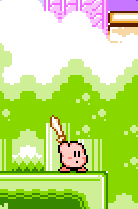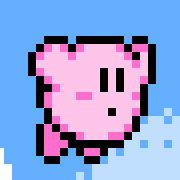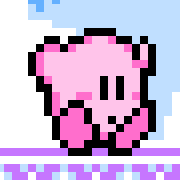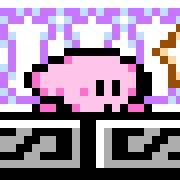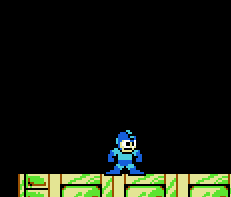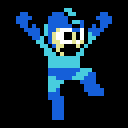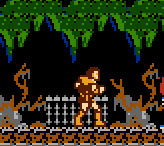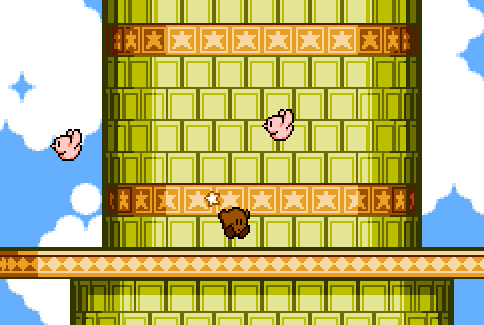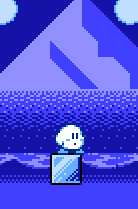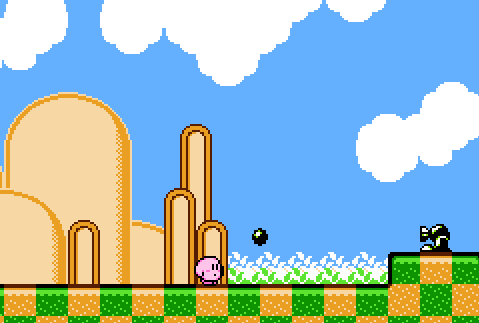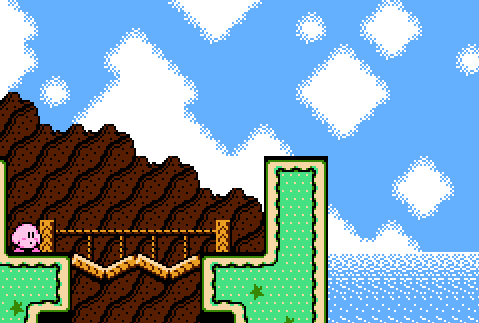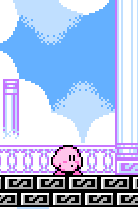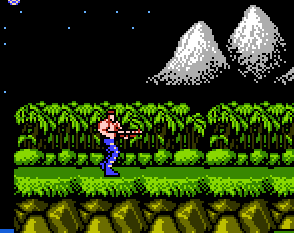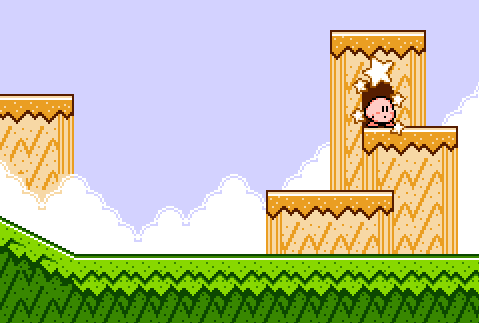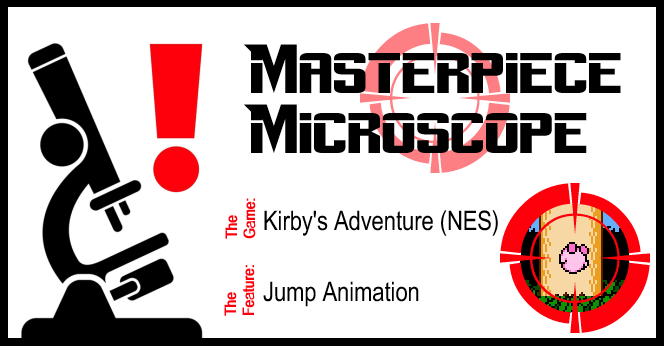
Masterpiece Microscope
Kirby’s Adventure Jump Animation
Masterpiece Microscope is a series in which I choose one great video game, then focus intensely on a single specific feature of its gameplay. Upon close examination, we may gain new insight as to just how great the game is, along with a better appreciation for the quality work that went into every little detail.
Behold:
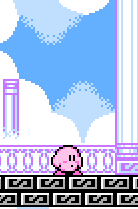
That is the standing jump animation for the protagonist sprite in Kirby’s Adventure, a great video game released on the 8-bit Nintendo Entertainment System console in 1993. Jumping is done by pressing the A button on the controller, with the height of the jump determined by the length of time the A button is held down, up to the maximum height as shown here. Kirby can change direction in midair, jump differing distances dependent on traveling speed, and even attack enemies below if he falls for a sufficient length of time.
Then again, he can also fly outright, affect his jumping trajectory depending on the activation of certain abilities, and even augment his midair attacking power through the addition of items gained from some said abilities, such as the sword, as seen here.
Honestly, though, as much as I would enjoy it, I do not wish to spend this space discussing the various nuanced alterations to Kirby’s jump that can be discovered in his NES outing. No, I just want us to focus in on that basic jump animation we see upon simply tapping the A button when we play the game.
I am really fond of the jump animation in Kirby’s Adventure, and I believe that it can help show what a true gem of a game it is. There are a few reasons I like it, concerning different aspects of the jump in question.
The Details
The pixel art on display here is pretty good. I am not going to sit here and say that it is explosively awesome, nor that it is the all-time best on the NES. Kirby is not an altogether-large character, and he is restricted to the three-color norm for NES character sprites. I think the character design is truly solid, but the strength of Kirby’s art is not in his static form. The magic is in his motion.
Every frame is crafted with care, with the animation progression showing off a splendid sense of evocative artistry. From the way that Kirby’s arms thrust upward, full of optimistic momentum:
To his cautious-eyed approach toward inevitable impact below:
And that brief moment of body squish to mark his inertia-dampening collision with the ground:
Those are really great frames, and show a bit more of a progression than many NES animations ever bothered to, even with consideration to other highly regarded titles. The result is a richer, more fleshed-out character, which feels more rewarding to control. These added expressions give Kirby more of a personality, one that is predicated on his pliability, his general sense for happy-go-luckily dealing with whatever life throws at him. This can be seen in how he absorbs impacts, often literally bouncing back into place.
For comparison’s sake, let us take a look at the jump animations from a couple other well-known NES video games.
First, we have Mega Man 2.
Mega Man 2 is one of the all-time greats, a challenging grind of high concept and fast action. The jump animation is not bad, exactly, but it is unnatural and devoid of basic sensibility. If you seriously consider this jump, does anything about it strike you as natural or aesthetically pleasing?
Have you, personally, ever tried to jump like this? And then tried to perform it many times in a row? In fact, have you ever decided that this, this goofy wide-mouthed arms-agape one-leg-lifted pose was the only jump you would ever perform for the rest of your life? Mega Man did.
But who cares? Nobody cares, in a general sense. Nobody minds, or even notices, that Mega Man’s jump sprite is kinda funky. This, in no way, removes from the greatness of Mega Man 2. Although, it does shine an interesting light on Kirby and his own jump. After all, if putting much work into Mega Man’s animation was unnecessary, why bother for Kirby? This reveals a touch of tender lovin’ care towards the pink puffball, as though his creators really did want to make him the best he could be.
Then we have Castlevania.
This, ladies and gentlemen, is a very simple two-frame animation. Yet, of course, Castlevania is a popular piece of early Nintendo lore, one of the trailblazers for a burgeoning platformer genre. When you really examine the jump animations of these gaming hits, though, you start to really realize how strangely complex Kirby’s leaping is.
Then again, perhaps that sentiment could be shared concerning the entirety of Kirby’s Adventure in general. Few, if any, NES cartridges can match the visual splendor on display in Adventure. The rotation of the Butter Building, alone, is a technical marvel that rivals similar effects in games produced even a generation later:
And there is our champion, leaping alongside it all.
Note, too, that the Nintendo development team had to also draw the frames in blue for use when Kirby had an ice power-up.
While I am sure it was not exactly the toughest task in the world to transpose the animation onto a different color scheme, it is still a neat effect, and one that was not often seen in 8-bit titles, although examples can be seen in games as early as the legendary Super Mario Bros and its Fire Flower palette swap.
The Aesthetic
Rather than try to breathlessly explain why Kirby’s simple jump is so gorgeous and beautiful, I am just going to show a couple more animated .gifs here, and hope that a few people out there see what I mean, and are overtaken with a wordless new appreciation for the simple beauty on display here. Join me in my crazed delirium.
Kirby has this frolicking, bouncing, pinballesque spirit to his movements. He is not the fastest character, nor the highest jumper, but he surpasses most in terms of recklessness and sheer courage. He throws his weight around visibly, his fluffy frame in constant strife with surrounding physics. Kirby is parkour. Kirby is a daredevil. Kirby is a fun-loving, adventurous soul.
There is a certain inherent joy to controlling Kirby. He moves as though he understands the implicit danger of his actions, which establishes a cool parallel between the on-screen perils as witnessed by the literal player and how Kirby, as an avatar figure, experiences them. In other words: Kirby burns in flames when he is touched by fire, and freezes into a block of ice when attacked with a wintry gust. We, as observer, see these threats coming, and have to watch Kirby, as character, deal with them with characteristic impact.
It may seem like a little thing; but, again, that is the point, and that immersion is something that many NES games utterly failed to even bother trying to cultivate a sense of. I would wager that there are even many modern games that fail to establish this sort of connection.
However, if there is one particular item that inspired this feature to be written, if there is one tiny element I want to truly hone in on, if there is one singular phenomenon I wish to put the Microscope to work toward in order to further establish the Masterpiece, it is this next ingredient.
The Somersault
Look at that basic Kirby jump animation again.
Did you notice the flip? That extra flourish Kirby adds at his apex? That glorious bit of acrobatics?
That is always a bonus. It is an unnecessary bit of indulgence to be consumed by those who obsess over such retro gaming matter. No sane, ordinary person would take note, especially while actually playing; then again, we do reward those who display exemplary athleticism and agility, do we not? So, perhaps others have noticed Kirby’s knack for spherical rotation, but were never quite able to put a finger on their fondness, figuratively speaking. Admit it: This is a stylish, sexy move.
Daniel Lamplugh once wrote a special feature for 1 More Castle entitled “Kineticism and Violence in Games.” While the subject does not correlate with Kirby entirely, the idea of kineticism does. To summarize: There is a sort of visceral satisfaction at having Kirby complete a somersault at the apex of his jump. You may notice, astute NES player, that Kirby manages to make this maneuver on every single jump, regardless of its height.
This lends the sense of a great amount of physical effort and activity being put forth into every one of Kirby’s hops. Along with the semi-randomized impact stars that shoot out upon every landing, the game goes to every length it can in order to provide the sensation that more is happening here than merely a change in pixel colors and positions. In this moment, my brain really thinks Kirby is jumping, and it looks pretty cool, and I am happy to help.
Now, of course, Kirby’s Adventure is not the only NES game to feature a somersault in its jump animation. To find a protagonist flipping completely head-over-heels, we can check out the legendary Contra.
Whoa, what a flipper! Here we see a man so macho that he is unafraid to twist his body through several turns in the course of a single twenty-foot vertical bound. In all seriousness, while we are comparing game by game, here we see a jump animation with more complexity than that of Mega Man or Castlevania, but with a sense of rigidity still intact. At no point in this jump is our Contra character doing anything other than rotating. This is so farcical that it can hardly serve as a connection point with the player. The good news is that Contra is so face-blastingly awesome that it hardly needs to show any form of empathy or player-character connectedness to be so good.
Yet, still, most NES character do not bother somersaulting at all. Kudos to Kirby for his extra effort. That little roll sets him far above the vast majority of 8-bit protagonists. For me, whether now or as a child, it has always helped make Kirby’s Adventure stand out in my mind. Many may readily acknowledge that Kirby’s Adventure is among the better NES titles; but, boy, it really is a couple notches above the norm in terms of how every aspect was carefully crafted to a high caliber.
I like what the developers did here, and throughout, how they executed these nuances and minor additions to the whole. The production value is clear. Every tap of the A button helps reveal why Kirby’s Adventure is among the greatest of the cartridge pantheon. Every trip across Orange Ocean is a foray into a world of child-like whimsy.
Like a Dream Land, really.
